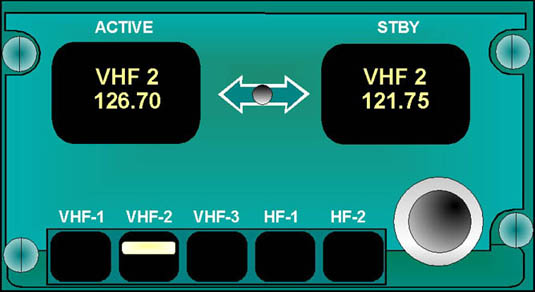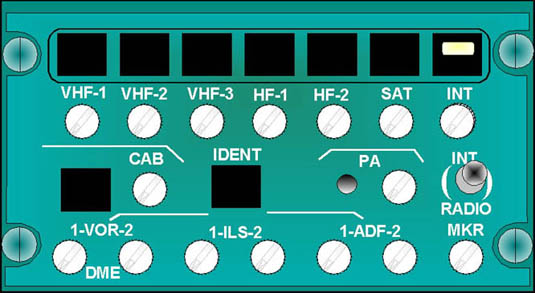Associated links (A98H0003)
-
Table of contents
Communications systems
Communications system description
Very high-frequency communications system
The VHF communications system consists of three separate, identical systems. The systems provide short-range, line-of-sight communications between the aircraft and the ground or other aircraft. In general, the number one radio is used for ATCa communications; the number two radio is used for ATIS, company communications, Oceanic clearances, and so on. The number three radio is normally used for ACARS.
High-Frequency communications system
The HF communications system consists of two separate, identical systems. The systems provide long-range communications between the aircraft and the ground or other aircraft.
Communication radio panels
Three CRPs are installed in the aft pedestal to enable the flight crew to tune the communications systems. Selecting one of the five radio switches causes the selected switch to illuminate and the associated active and standby frequencies to be displayed. New frequencies are placed in the standby memory by turning the frequency selector knob and are transferred to the active mode by use of the transfer button.
Audio control panels
There are three ACPs: two on the aft pedestal and one at the observer station. The ACPs provide transmit and volume control for the communication radios, interphones, and PA system, as well as volume control for the navigation receivers. An INT/RADIO switch provides the same function as the PTT switch on the control wheel. When this switch is pushed and held to INT, flight interphone transmission is possible. When the switch is held in the RADIO position, radio transmission is possible.
Flight interphone system
The flight interphone is used by members of the flight crew to communicate between each other in the cockpit and is controlled by the three ACPs. When the full-face oxygen masks stowage box doors are opened, the boom microphone automatically switches to the mask microphone. Flight interphone transmitting can be achieved with the PTT switch on either control wheel, the INT switch on the ACP, or any radio PTT switch if the MIC INT button is pushed on the ACP. When transmitting on interphone, the standard Swissair practice is to use the INT switch on the ACP.
Service interphone/call system
The service interphone/call system enables communication between the cockpit and the cabin crew stations and the maintenance service areas. The call system is used to alert the flight crew or cabin crew that another station is calling.
Passenger address system
The PA system enables the flight crew and cabin crew to address passengers throughout the cabin and in the lavatories.
Selective calling system
SELCAL operates in conjunction with the VHF and HF systems to provide visual and aural indications that the aircraft is being called by a ground station.
Cockpit voice recorder system
The voice recorder system automatically records the last 30 minutes of all flight and service interphone and radio communications initiated and received by the flight crew. A cockpit area microphone, located in the recorder panel in the overhead panel, sends ambient cockpit sounds to the CVR to be recorded. Boom microphones also send ambient and voice sounds to the CVR to be recorded as "hot microphones," independent of the position of their respective PTT switches. Additionally, when the captain’s or first officer’s full-face oxygen mask is removed from its respective oxygen mask stowage box and the box door is opened, the respective boom microphone is switched off and the microphone in the mask is recorded as a hot microphone, regardless of whether the PTT switches are used.
Aircraft communications addressing and reporting system
ACARS provides two-way data communications through VHF 3 or SATCOM through the ACARS management unit.
Satellite communications system
SATCOM uses satellite and ground stations to relay transmissions to and from the aircraft.

